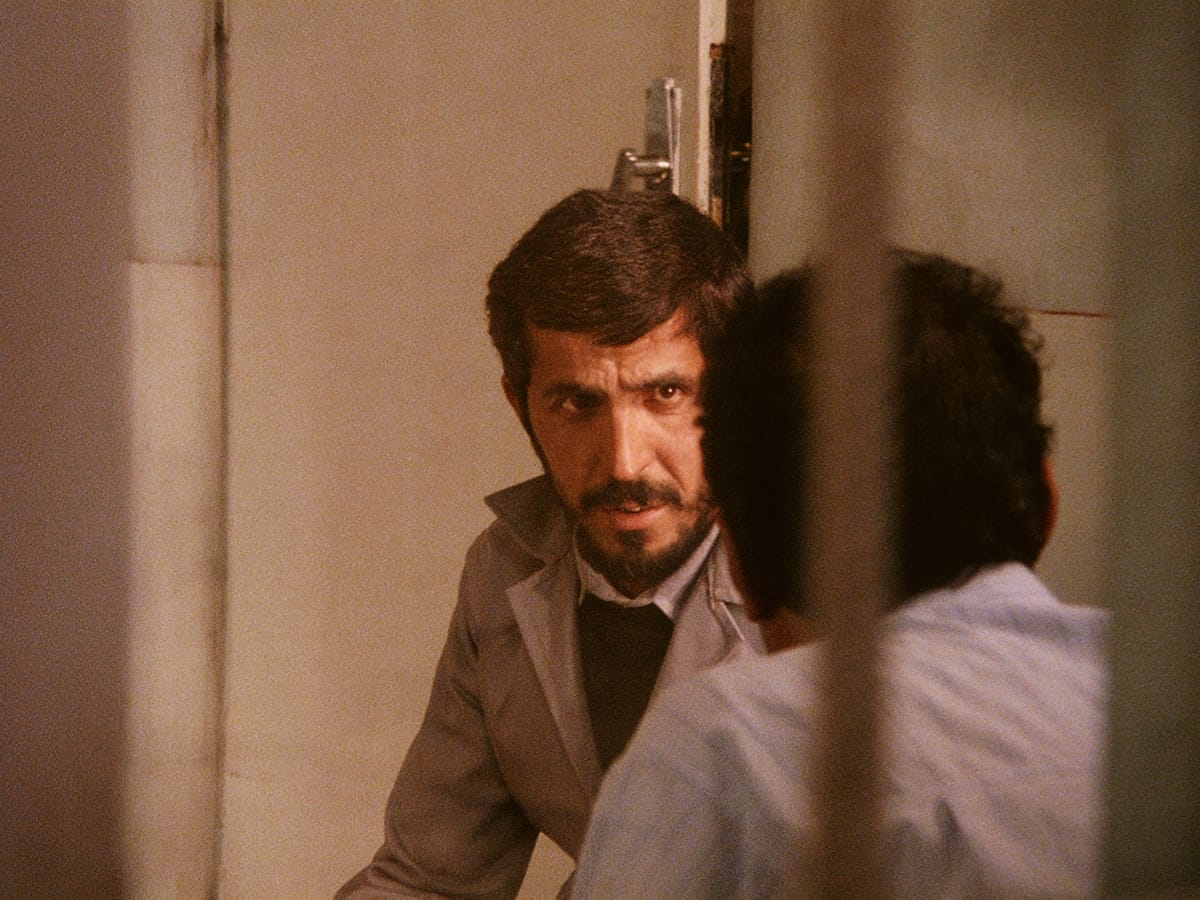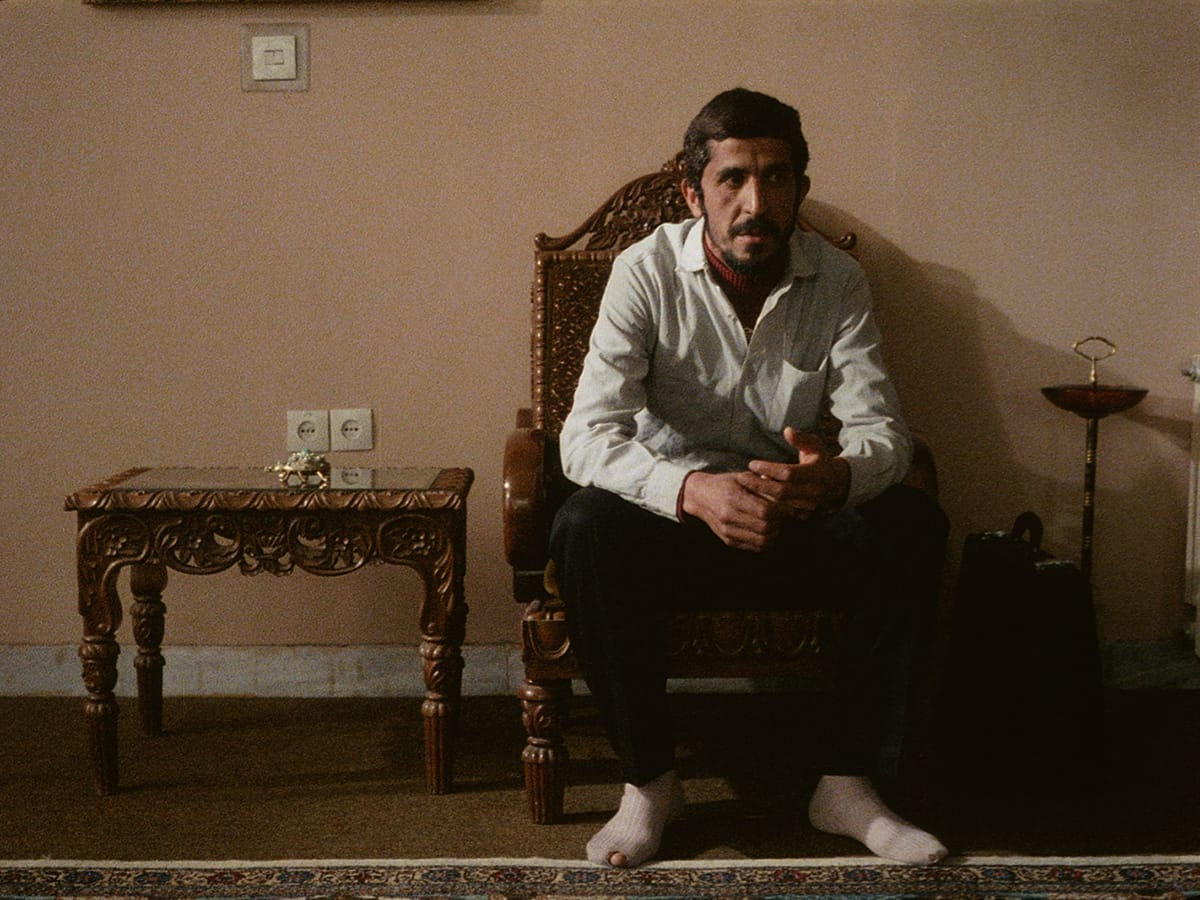What Makes an Auteur? An Analysis of Abbas Kiarostami’s Close-Up
Andrew Tomei

Director Abbas Kiarostami speaks to the imprisoned Sabzian.
In the pantheon of great filmmakers, several figures have become strongly associated with one particular style. Although filmmaking is, in the most literal sense, a collaborative process involving hundreds of people working in dozens of different fields, it is the director who most often receives credit for innovating a particular filmmaking style or technique. This trend is no accident but, rather, the result of a conscious paradigm shift among film critics in which the director came to be seen as the film’s true “author,” or “auteur,” which film critic and theorist André Bazin describes in his 1957 essay “On the ‘Politique des auteurs.’” In this essay, I will consider the work of Iranian filmmaker Abbas Kiarostami through the lens of Bazin’s Auteur Theory. In particular, I will focus on his 1990 film Close-Up and how it both presents and interrogates the concept of the auteur director.
When assessing Close-Up’s status as an auteurist work, a good first step is to examine how the thematic and aesthetic qualities of Close-Up compare with those of other Kiarostami films. This step is useful because, according to Bazin, one of the defining characteristics of an auteur’s filmography is a certain degree of homogeneity: “Whatever the script, the same story is always being told … the same viewpoint and the same moral judgment are always being cast on the action and the characters” (356). This is not to say that an auteur’s works are repetitive and unoriginal, however. Rather, an auteur often returns to the same themes and characters throughout their career, but explores them from a slightly different perspective each time. For example, one hallmark of Kiarostami’s films is the way they often blur the line between reality and fiction. This can be seen not only in Close-Up, but also in two of his subsequent films, And Life Goes On (1992) and Through the Olive Trees (1994). Both of these later films largely revolve around the making of a real Kiarostami film within their otherwise fictional narratives: the former is about Kiarostami returning to the village where he filmed his earlier film Where Is My Friend’s House (1987) after it has been struck by an earthquake, and the latter is about a fictional romance between two actors featured in a brief scene from And Life Goes On. The use of metafiction in each of these films creates a sense of self-awareness that never subsides, as if Kiarostami wants his audience to always know that they are watching a movie, a movie about another movie. In other words, even though the other Kiarostami films I have mentioned are in some way about the making of a Kiarostami film, Close-Up is the only film whose central narrative focus is its own making. Conversely, And Life Goes On and Through the Olive Trees only use the making of a previous Kiarostami film as a backdrop for their respective fictionalized narratives.
Unsurprisingly, since these films are reenactments of events from Kiarostami’s own life, the director himself has a role of some kind in all of them. As a result, Kiarostami becomes a character in his own film – complete with his own personality and priorities – rather than the conventional invisible, omniscient, and impartial storyteller behind the camera like most directors. In fact, Kiarostami inserting himself into his own films can be read as a literal interpretation of Bazin’s assertion that “To a certain extent at least, an author is always his or her own subject” (361). In the case of And Life Goes On and Through the Olive Trees, Kiarostami appears in the form of unnamed avatars who, though clearly based on him, are played by other actors. Close-Up, however, is the only one of the three in which Abbas Kiarostami actually plays Abbas Kiarostami. His first on-screen appearance comes in a scene early in the film, in which he converses with Hossain Sabzian — also playing himself — who has been jailed for impersonating Iranian filmmaker Mohsen Makhmalbaf and tricking a family into making a movie with him. On the surface, Kiarostami’s role in this scene is passive; one might be tempted to say that his function in this story is merely to recreate the events that Sabzian facilitated and is now recounting. In other words, he is serving as a kind of secondary narrator, rather than as the Narrator.

Hossain Sabzian, the accused impersonator.
However, the scene contains a few subtle elements that complicate the audience’s understanding of each man’s respective role in the film. One such element is the way Kiarostami blocks the scene: in the first shot, Kiarostami sits with his back to the camera—and, by extension, to the audience—as he listens to Sabzian describe his situation, while the camera slowly zooms in on the latter’s face. By placing himself in front of the camera, Kiarostami finds himself in the unusual position of being both an observer (of Sabzian) and one who is observed (by the audience). Even when the camera cuts to an over-the-shoulder shot directly facing Sabzian, the back of Kiarostami’s head dominates the right-hand side of the frame. In addition, the visual duality of the scene is complemented by the meta-irony of the conversation itself, with Sabzian asking Kiarostami to make a film about his “suffering—the very film we are now watching.
This near-breaking of the fourth wall, along with the specific blocking decisions made in this scene, underlies the way in which Close-Up problematizes questions of whose story this film is really telling: Kiarostami’s or Sabzian’s. For instance, once the trial actually begins, and Sabzian begins to recount the events of his stay with the Ahankha family, Kiarostami frequently interjects and presses Sabzian to dig deeper into his own psyche. Furthermore, his frequent interruptions of the proceedings of the trial go more or less unquestioned by the judge of the trial. Therefore, even though Sabzian is the diegetic narrator of the film—recounting events to the judge in the courtroom, with the scenes in the Ahankha’s home essentially being visual representations of Sabzian’s narration—Kiarostami seems to be the real “judge” in the trial, whose authority seemingly superseded even that of the actual judge. As a result, the film simultaneously depicts Kiarostami as a character within the film and as a kind of “eye in the sky” figure existing outside the film while still controlling the words and actions of the characters in the film.
On the one hand, because this is a film, one can argue that everything about the film came straight from Kiarostami’s script and direction. In other words, without Kiarostami, the film Close-Up would not exist in the first place. On the other hand, it is equally true that most of what happens in the film, both on-screen and off-screen, happened more or less verbatim in the real world—which would still be the case even if Kiarostami had not dramatized them in Close-Up. This reality connects back to one of Bazin’s biggest criticisms of the theory of “Politique des auteurs,” specifically the notion that a great film’s success and acclaim is owed solely to its director’s inherent brilliance. Instead, he suggests that the historical context of the production of the film may also play a part in its critical reception: “what is genius … if not the conjuncture of indisputably personal talents—the gift of one’s fairies—and the historical moment?” (350). Close-Up is an especially extreme example of this intersection between creativity and history, because it takes so few liberties with true events as they transpired in the real world—even going so far as to have the real people involved to play themselves in the film. Indeed, perhaps Close-Up functions as little more than a platform for Sabzian’s story, with Kiarostami’s only role being to amplify Sabzian’s voice. If we are to assume, then, that originality is a necessity for a film to be considered auteurist, as Bazin seems to believe, then Close-Up is not so much an auteurist masterpiece as it is an unusually meta documentary. The film is careful never to take a stance in either direction, leaving it entirely to the audience to decide which of the two men is the one telling the story.
Throughout Bazin’s writings about the “Politiques des auteurs,” one very peculiar notion arises: in many ways, reality is an auteur’s biggest foe. This puts any filmmaker who aspires to become known as an auteur in an almost Catch-22-esque situation: they face the virtually unrealistic expectation of being able to form something out of absolutely nothing over and over again, because, if their films take any inspiration from the events of the real world, then their status as auteurist works is immediately called into question. Furthermore, as Bazin repeatedly emphasizes, sometimes the standards that define an auteur can be boiled down to a simple preference of taste among the self-proclaimed arbiters of such a designation. Of course, this is not to say that many directors do not pour their heart, mind, and soul into their works. Indeed, despite the fact that Close-Up, in some ways, fails to meet the criteria of an “auteurist” work as outlined by Bazin, it is still plainly obvious how much the film meant to Kiarostami, as well as the rest of the people involved. But it is not because Kiarostami aspired to be remembered specifically as an “auteur”—rather, he simply wanted to expand the boundaries of what the medium of film could do.
Works Cited
Bazin, André. “La politique des auteurs.” Cahiers du Cinema, no. 70. April, 1957.

